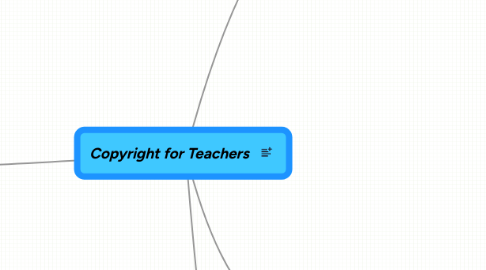
1. Staying Up To Date
1.1. The Creative Commons Site
1.2. Website to help teachers teach about copyright (and the source for most of this map)
1.3. If you don't mind heavy reading...
2. Fair Use
2.1. What the public is legally allowed to do with the material in question
2.1.1. Four factors of fair use
2.1.1.1. What is the nature of the content in question? (creative or factual)
2.1.1.2. How much are you taking?
2.1.1.3. What is the purpose and character of your use?
2.1.1.4. What effect are you going to have on the market or potential market of the original content?
2.1.2. The definition of fair use is dynamic. As new technologies arise what is and isn't legal is constantly changing.
2.1.2.1. Generally, transformative use is fair. Transformative use is any use where a new work is being created, for example commentary, parody, new reporting, ect.
2.1.2.2. After the invention of the VCR recording for personal use (time-shifting) also became fair use
2.1.2.2.1. While recording for personal use is fair use, sharing of copyrighted works on a large scale (i.e. napster) isn't
2.1.3. Fair use has nothing to do with citing sources, it is different than plagarism
2.2. An example of a teacher practicing fair use
2.2.1. A teacher might take a popular song, like "Before He Cheats" by Taylor Swift
2.2.2. The teacher can copy the melody of the song and change the lyrics to match a subject their interested in teaching (for example, what plagiarism is)
2.2.2.1. Even though it is creative work, because of the transformative nature it is protected
2.2.2.2. The entire song is being taken, but the entire song is also being transformed
2.2.2.3. The purpose of the original work was purely for entertainment, the new work serves a different purpose as an educational tool
2.2.2.4. This parody is unlikely to harm the market for Taylor Swift, because her music is directed to a different audience
2.2.3. The result could be something like this
3. Creative Commons
3.1. What an author states as the permitted uses of their work
3.1.1. The author picks and chooses with copyright protections they want to keep, and which they are willing to share
3.1.1.1. For example, an artist may allow others to use their work but not modify it or, may allow it for public use, but not commercial
3.1.2. When using another individual's work it's important to use it in accordance with their creative commons
3.1.3. Give authors the credit that they deserve, cite them for their work
4. Standard Copyright
4.1. Owning an idea or an image. Intellectual property.
4.1.1. Only the copyright owner is allowed to produce and use their work, with some exceptions
